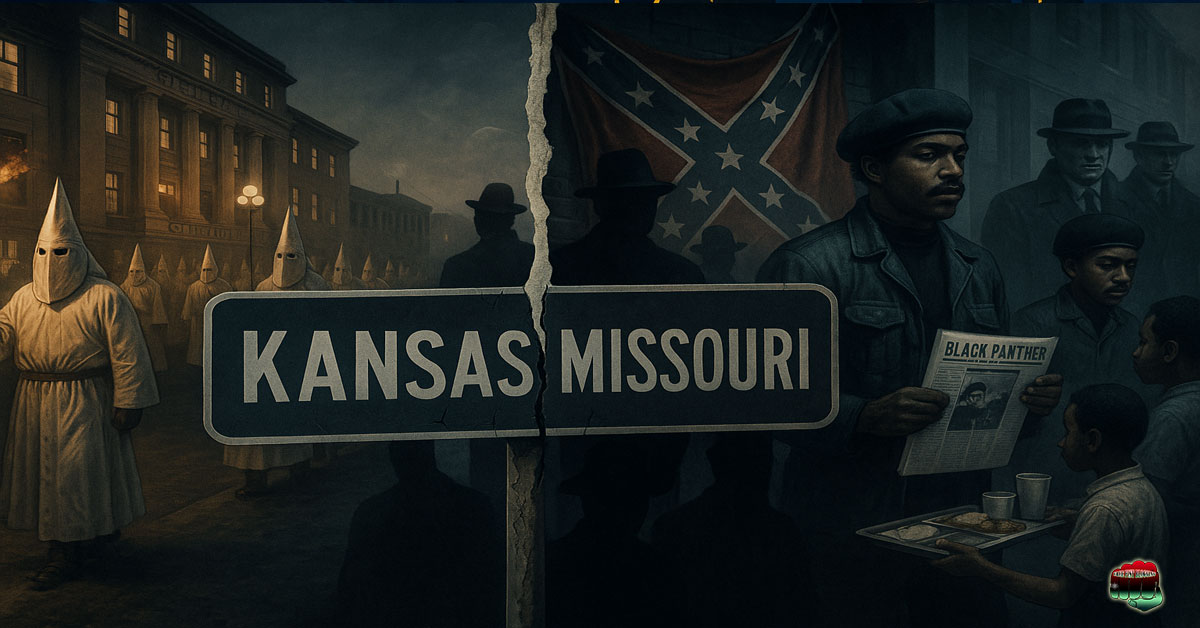Kansas called itself a “free state,” while Missouri flew the Confederate banner. Yet in 1930s Kansas City, Kansas, the Ku Klux Klan thrived — and decades later, the FBI saved its firepower for the Black Panthers instead.
By Julius Rangal, InnerKwest Investigations Team
Published: August 30, 2025
Introduction
The history of American law enforcement is often presented as a steady march toward justice, but beneath the veneer lies a contradiction: why did the FBI unleash its full fury against the Black Panther Party, yet consistently avoid a sustained crackdown on the Ku Klux Klan? This double standard is not an accident of oversight; it reflects America’s racial hierarchy, political priorities, and the weaponization of law enforcement against those who dared to challenge the established order.
Nowhere is this paradox sharper than in Kansas City, Kansas—a “free state” city that, by the 1930s, was thoroughly infiltrated by the Klan, even while its neighbor across the river, Missouri, carried the legacy of the Confederacy. This borderland context makes the FBI’s selective blindness all the more revealing.
The FBI and Its Mission: Who Gets Branded a Threat
When J. Edgar Hoover assumed leadership of the Bureau of Investigation (later the FBI) in 1924, he built an agency obsessed with hunting “internal enemies.” But his definition of enemies was highly selective. Civil rights leaders, communists, socialists, and militant Black organizations were treated as existential dangers. White supremacist groups, even those responsible for church bombings, lynchings, and terror campaigns, were rarely considered a comparable national threat.
For Hoover, “subversion” meant anything that destabilized the racial, political, and economic status quo. The Black Panthers—with their armed patrols against police brutality, free breakfast programs, and talk of revolutionary change—fit squarely into that category. The Klan, however, despite its record of mass violence and infiltration of public institutions, was often excused as a matter of “local disorder,” not national security.
A Borderland of Contradictions
To understand Kansas City’s story, one must first grasp its geography.
- Missouri, the Slave State: Missouri entered the Union in 1821 as part of the Missouri Compromise and fought with the Confederacy during the Civil War. Its soil bore the blood of guerrilla fighters like Quantrill’s Raiders, whose pro-slavery violence became infamous.
- Kansas, the Free State: Kansas, after years of violent conflict known as “Bleeding Kansas,” entered the Union in 1861 as a free state. It carried the reputation of a place where freedom triumphed over bondage.
Yet the irony is staggering. By the 1920s and 1930s, Kansas City, Kansas—supposedly in “free” Kansas—was riddled with Ku Klux Klan infiltration. Torchlight marches blazed down Minnesota Avenue, Klan members sat on school boards and police forces, and the promise of freedom collapsed under the weight of white terror.
For Black residents, the border was not one between free and slave, but between Confederate Missouri’s legacy on one side and hypocritical Kansas’s racial double standard on the other.
Kansas City, Kansas: A Case Study in Klan Power
Archival reports and oral histories show that Klan members in Kansas City, Kansas, were not marginal figures. They were policemen, judges, businessmen, and politicians. Their influence seeped into daily governance, from hiring practices to law enforcement.
When a Black resident faced harassment or violence, the perpetrators could often count on sympathetic ears in city hall or the police department. Investigations fizzled. Civic life carried on.
The Klan was not in hiding—it was parading through downtown, staging rallies, and embedding itself in the machinery of civic authority. And yet, the FBI never launched a sweeping campaign to uproot it. Instead, federal authorities leaned on local officials—many of whom were complicit—to “monitor” Klan activity, ensuring that accountability evaporated before it began.

📜 Historical Snapshot: The Klan in Kansas City, Kansas
The 1930s Legacy
- By the early 1930s, the Ku Klux Klan had thoroughly infiltrated Kansas City, Kansas institutions—from city hall to the police department to the courts. Complaints of intimidation or assault from Black residents often disappeared into the void.
- Torchlight parades marched boldly down Minnesota Avenue, staged as spectacles of power during election seasons. Far from being a fringe group, the Klan was woven into civic life.
- Notable Figures:
- Dr. Hiram Wesley Evans — Imperial Wizard of the national Klan, whose presence at Kansas rallies lent credibility to local chapters.
- Rev. Gerald Winrod (“the Jayhawk Nazi”) — Wichita preacher and Klan ally who lectured in KCKS, blending white supremacy with antisemitism and pro-fascist rhetoric.
- Local “exalted cyclopses” (chapter heads) tied to Wyandotte County ward bosses later reappeared in judicial and commissioner campaigns, embedding Klan influence into political life.
Connection to Modern Governance
- Police Culture: Oral histories reveal continuity between Klan-linked officers of the 1930s and later policing patterns of redlining enforcement and discriminatory arrests in Black neighborhoods.
- School Boards: Former Klan members sat on school boards into the 1940s, shaping segregated policy. Present-day achievement gaps across KCKS schools still bear this imprint.
- Political Families: Surnames tied to 1930s Klan organizing reappear in county politics and legal rosters decades later, showing how institutional legacy outlived open affiliation.
“The Klan was never underground in Kansas City, Kansas—it walked right through city hall doors.”
Source Notes: Kansas City Kansan (1930s editions); The Kansas City Call; David Chalmers, Hooded Americanism; Craig Miner & Donald Beach, Kansas: The History of the Sunflower State; Kansas Historical Society archives.
The Black Panther Party: A Different Response
By the late 1960s, a different kind of organization rose to prominence: the Black Panther Party. Founded in Oakland in 1966, the Panthers armed themselves to resist police brutality, organized free breakfast programs, and demanded systemic change.
Hoover reacted with fury. He labeled the Panthers “the greatest threat to the internal security of the country.” Under COINTELPRO (Counterintelligence Program), the FBI infiltrated chapters, spread disinformation, and orchestrated raids. Leaders like Fred Hampton were assassinated in their sleep in coordinated FBI–police operations.
The contrast with Kansas City’s Klan is stark. While Klan parades went largely unchallenged, the Panthers’ breakfast programs were considered subversive enough to warrant destruction.
The Racial Double Standard in Action
- Target Definition
- Panthers: Cast as radicals and revolutionaries threatening national security.
- Klan: Treated as local troublemakers, sometimes even patriots, despite terrorism.
- Institutional Overlap
- FBI agents, local police, and judges often shared racial biases with the Klan. In Kansas City, Kansas, that overlap guaranteed stalled investigations.
- Political Utility
- Attacking the Panthers allowed Hoover to showcase the FBI as a Cold War bulwark against communism. Targeting the Klan would have risked alienating Southern politicians and sections of the white electorate.
Kansas City’s Silence and Black Resistance
For Black Kansas Citians, the Klan’s presence was no secret. Oral histories describe the routine of intimidation—cross burnings on the outskirts, “whites only” practices in schools and jobs, parades meant to instill fear.
Yet the absence of FBI intervention did not mean passivity. Black churches, NAACP chapters, and community leaders fought back, often at great risk. They lacked federal protection, but they built networks of resilience. Ironically, when later generations embraced self-defense under the Black Panther banner, it was precisely that resistance that triggered the federal crackdown.
The Broader Picture: Fear of Black Autonomy
The FBI’s disparate treatment reveals a deeper truth. The Klan’s violence, however grotesque, reinforced the racial order. The Panthers, by contrast, offered a blueprint for Black autonomy—community schools, clinics, and security forces under Black control. That vision was far more terrifying to Hoover than any burning cross.
Kansas City, Kansas, in the 1930s embodied this contradiction: a free-state city with a Confederate spirit. The Panthers, decades later, embodied its antidote: liberation. And it was the antidote, not the poison, that the FBI sought to extinguish.
Lessons for Today
The echoes remain. Kansas City still wrestles with inequities rooted in its past. Nationally, the question of who gets branded a “terrorist” and who gets excused as a “patriot” continues to expose a racial double standard.
To face Kansas City’s Klan history is to confront a painful reality: the federal government has historically tolerated white supremacist violence while criminalizing Black resistance. Until that imbalance is addressed, the ghosts of both the Panthers and the Klan will continue to haunt American democracy.
Conclusion
The FBI’s selective war on “domestic enemies” reveals less about crime than about power. The Klan, despite its brutality, upheld the status quo. The Panthers, despite their community programs, threatened to transform it. Kansas City, Kansas, shows how deeply the Klan could embed itself in civic life without drawing federal firepower, even in a state that claimed the mantle of “freedom.”
This is not just past hypocrisy—it is a warning. If America cannot confront why the Panthers were crushed while the Klan was tolerated, it risks repeating the same cycle: suppressing those who fight for justice while excusing those who cling to domination.
🖨Author Bio
Julius Rangal is a writer with the InnerKwest Investigations Team, focusing on civil rights history, political power structures, and the hidden legacies that shape America’s present. His reporting blends archival research with contemporary analysis, connecting overlooked historical patterns to today’s struggles for justice.
Support InnerKwest: Powering Truth & Excellence with Bitcoin
At InnerKwest.com, we are committed to delivering impactful journalism, deep insights, and fearless social commentary. Your Bitcoin contributions help us execute with excellence, ensuring we remain independent and continue to amplify voices that matter.
Support our mission—send BTC today!
🔗 Bitcoin Address: 3NM7AAdxxaJ7jUhZ2nyfgcheWkrquvCzRm© 2025 InnerKwest®. All Rights Reserved.
InnerKwest® is a registered trademark of RedaJames Inc.
No part of this publication may be reproduced, distributed, or transmitted in any form or by any means without prior written permission. Unauthorized use is strictly prohibited.
Thank you for standing with us in pursuit of truth and progress!![]()


